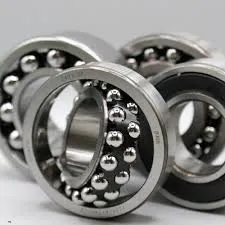
Dec . 19, 2024 00:10 Back to list
thrust ball bearings applications
Applications of Thrust Ball Bearings
Thrust ball bearings are specialized types of rolling element bearings designed to accommodate axial loads in one direction and to support shafts, gears, and other machinery components in applications requiring stability and reduced friction. These components are crucial in various mechanical systems and industries. This article explores the applications of thrust ball bearings, highlighting their significance in different fields and their contributions to efficiency and performance.
1. Automotive Industry
One of the most prominent applications of thrust ball bearings is in the automotive sector. These bearings are frequently utilized in vehicle transmissions, allowing for smooth operation and efficient power transfer from the engine to the wheels. In automatic transmissions, thrust bearings support the input and output shafts, enabling them to handle axial loads efficiently while minimizing wear and tear. Additionally, they are found in clutches, where they help maintain the alignment of components and reduce friction during engagement and disengagement.
2. Aerospace Applications
Thrust ball bearings are vital in the aerospace industry, where they are used in aircraft engines, landing gear systems, and various rotating mechanisms. In jet engines, thrust bearings withstand the high axial loads generated during operation, ensuring the reliability and longevity of the engine components. Additionally, in landing gears, these bearings provide stability and support during take-off and landing, contributing to overall safety.
3. Industrial Machinery
In various types of industrial machinery, thrust ball bearings are employed to support heavy loads and facilitate smooth operation. They are commonly found in gearboxes, where they help sustain the weight of gears and ensure optimal performance. Machinery such as cranes, lifts, and conveyors also benefit from thrust bearings, as they allow for efficient movement and precise control. By reducing friction between moving parts, these bearings enhance the overall efficiency of machines, leading to lower energy consumption and higher productivity.
thrust ball bearings applications

Construction equipment, such as excavators, bulldozers, and cranes, often relies on thrust ball bearings for their operational efficiency. These bearings support the axial loads encountered during lifting and moving heavy materials, ensuring the equipment operates smoothly under challenging conditions. The durability of thrust ball bearings makes them suitable for use in rugged environments, where they can withstand exposure to dirt, moisture, and varying temperatures.
5. Marine Applications
In the marine industry, thrust ball bearings are essential for various applications, including propulsion systems, winches, and steering mechanisms. They help manage the axial loads generated by propellers and other rotating components, contributing to the overall efficiency and stability of marine vessels. Additionally, thrust bearings in winches assist with the smooth operation of rope and cable systems, which are crucial for docking and cargo handling.
6. Home Appliances
Beyond industrial and heavy-duty applications, thrust ball bearings are also employed in everyday home appliances. Devices such as washing machines, dryers, and mixers utilize these bearings to support rotating parts and ensure smooth operation. In washing machines, for example, thrust bearings help balance the drum during high-speed spins, reducing vibrations and noise. This application highlights the versatility of thrust ball bearings in enhancing the performance of household appliances.
7. Robotics and Automation
As robotics and automation technologies advance, thrust ball bearings play a crucial role in enabling precise movement and control. In robotic arms and automation equipment, these bearings support various joints and actuators, allowing for accurate positioning and smooth operation. As industries increasingly adopt automation, the demand for reliable thrust ball bearings continues to rise, underscoring their importance in modern manufacturing processes.
Conclusion
Thrust ball bearings are indispensable components across a wide array of industries, from automotive and aerospace to industrial machinery and home appliances. Their ability to support axial loads, reduce friction, and enhance operational efficiency makes them a crucial element in ensuring the reliability and performance of various systems. As technology progresses, the demand for advanced thrust ball bearings will likely grow, further cementing their significance in both traditional and emerging applications.
Latest news
-
Premium Deep Groove Ball Bearings | High Speed & Reliability
NewsAug.29,2025
-
Durable Scaffolding Clamps - Secure & Reliable Tube Connectors
NewsAug.28,2025
-
Common Failures in Thrust Ball Bearings and Solutions
NewsAug.22,2025
-
How Tapered Roller Bearings Can Take Shock Loads
NewsAug.22,2025
-
Angular Bearings in High-Precision Spindles
NewsAug.22,2025
-
The Impact of Misalignment on Cylindrical Roller Bearing Performance
NewsAug.22,2025
